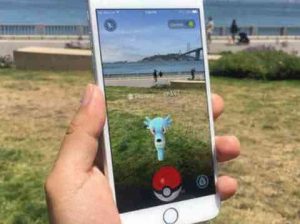Pokémon Go is the hottest craze right now and is quickly becoming one of the most viral mobile applications of all time. Eleven percent of U.S. Android owners have installed the app and six percent are engaged in the game on a daily basis, staring at their phone screens as they walk the streets looking for animated characters. Pokémon Go use now surpasses Twitter’s daily users. People are spending more time in its app than on Facebook. Besides being the hottest new mobile game and a major phenomenon, it’s most significant impact is that it has introduced of a totally new disruptive technology to the consumer entertainment landscape.* Pokémon Go represents one of those moments when a new technology, in this case augmented reality, breaks through from being a niche use by early adopters to going mainstream.
Pokémon Go players move through the physical world following a digital map on their screens, searching for cartoon creatures that appear at random. They look through their smartphone cameras to find Pokémon. When an animated creature appears, they toss Pokéballs at it until it is subdued. (If you haven’t yet been caught up in the Pokémon Go craze and want to learn what the game is all about, check out this video).

Up until now entertainment options where basically limited to board and card games, 2D screen-based entertainment and games in the home or on the mobile screen, and visits to entertainment venues. Pokémon Go has now brought the mixed reality of combining augmented reality and real world reality to everyone. Why is it so disruptive? Because it has expanded screen-based entertainment and game options into the entire real 3D world. Previously the only 3D real world options were available at an entertainment venue. Pokémon Go has now shown us that the entire world can be the entertainment venue. The fidelity of the game is so much higher than playing on a 2D screen. The game is free and pokécoin purchases are very inexpensive. It is social at Pokémon Go gym locations. You no longer have to pay to go to an entertainment venue to play a game or be entertained in the real world.
Pokémon Go is only the beginning of the mixed reality entertainment options that will be emerging in the near future. It is also the future of how we’re going to interact with computers. Augmented reality entertainment will be slicing into the available market pie of consumers’ available leisure time and discretionary spending. This mixed reality is a completely new form of competition that location-based entertainment venues need to take very seriously. To continue to attract paying customers, entertainment venues will need to raise the quality, the attractiveness, the Fidelity of the entertainment and social experiences they offer.
* The first augmented reality video game was Ingress by the same developers of Pokémon Go, but it never captured a large enough fan base to attract a mainstream audience.



